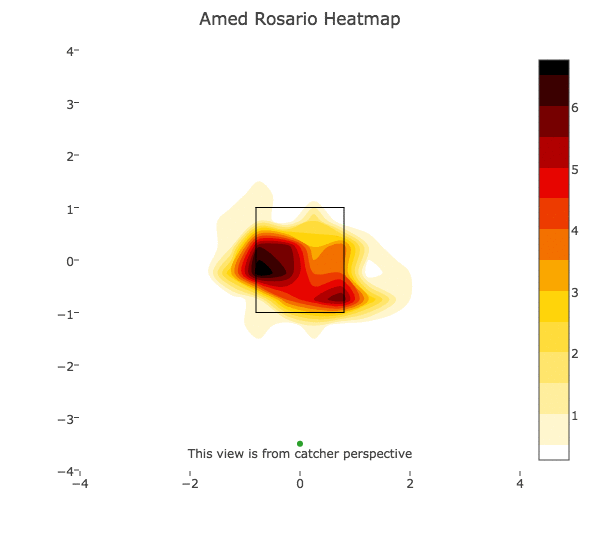Projecting prospects is extremely difficult. In the case of Amed Rosario, this could not be more apparent. Everybody has been wrong so far, including myself. I ranked him 25th overall in a December update of my top prospect list back in 2016. I had him ahead of Vlad Guerrero Jr., which in retrospect is laughable. Others had Rosario inside their top 5. It might be hard to place yourself in the same state of mind, but I’m not citing examples of those who were aggressive on Rosario, this was the consensus.
Nearly every tool of his projected to be above average, with Rosario’s game power the one skill lagging behind. Some were optimistic even that would develop. What fantasy owners and Mets fans see instead is a player who has been overwhelmed in his first two seasons. The negatives I’ll discuss throughout this column. The positives begin they righty’s age.
At 22 years old, digging for optimism is simple. Historical aging curves suggest players improve until they peak around age 27. Exceptions to this rule, however, can render aging curves relatively useless. Those exceptions over the last few years have been louder than ever thought possible, causing quick dismissal of players once showered with similar praise (see Gleyber Torres and Juan Soto).
On top of Rosario’s age let’s toss out another positive: improvement. The baseline production on Rosario’s line is poor, but it’s better than last season. He cut his swinging strike rate by 5 percent, still leaving him in the bottom quarter of the league. Baby steps are still steps. This brought his strikeout rate down below 30 percent and improved other discipline peripherals, but the league has attacked him largely the same since last season. This is once again a testament to his youth. Rosario is still in the initial stage of adjusting to the league’s first crack at the holes in his swing. The league has no need to continue adapting if his wRC+ sits 20 points below average and he can’t convince pitchers it’s time to move off an amount of sliders elevated above league average.
These holes cast a bit of doubt on whether you can upgrade his present hit tool to average as well (spoiler: you can’t).
Rosario is struggling mightily against both fastballs and sliders. On fastballs, he’s swinging through letter-high pitches that are in the zone. On sliders, it seems to be an issue of plate coverage and simple ability to make contact. The sliders his is missing are concentrated on the outer third, and they’re discouragingly also in the zone. What he is hitting seems to be pitches on the inner third, which isn’t surprising for most hitters, but given the zone of success doesn’t extend to places of importance, like slightly up or out, is concerning.
Compare Rosario to a player like Dansby Swanson, who in the aggregate hasn’t been significantly better than Rosario (85 versus 80 wRC+), but possesses some traits in his zone that might be interesting to see Rosario adopt.

Heatmap of all hits for Dansby Swanson and Amed Rosario, 2018
Swanson’s plate coverage seems to be better than Rosario’s. The caution I have with this matter relates to whether Rosario shouldn’t adjust to try and maintain the hope that he does actually have some average to plus game power hidden in his bat. I don’t think he’ll ever have plus power the other way, so if he does trend towards Swanson’s inside-out profile, it might sap whatever we believe his power ceiling actually is. But for the present state of his development, it might allow him to be substantially more successful on those sliders he is continually swinging through on the outer third. It may not fix his fastball hole middle-up in the zone, but again, baby steps is the only thing needed at the age of 22.
So should Rosario adjust his swing? This is where I struggle most, particularly because of what I was considering in the last paragraph: does Rosario eventually want to tap into more power? His current swing is little bit funky, possessing a small leg kick that strays out over the plate, almost as if it’s helping to close off his front side prior to his swing, which manifests in his tendency to hit the ball to centerfield (42 percent, second highest among qualified hitters). If he allowed himself to open up a little bit more, there is a chance we could see some of the pull power come out, but that would logically make him even more prone to sliders on the outer third.
A balancing act is required to decrease the severity Rosario’s current problems, but at the same time fix his offensive production. This is one of the difficulties with Rosario. I would hope that there could be a power shift to Rosario pulling the ball more in counts where he is ahead and protecting while behind. Most hitters do this naturally, but the results if Rosario went aggressive to his pull side early would be intriguing. This might create two approaches that are too far apart to reconcile, especially for a 22-year-old. It’s surely more complex, but it would also allow him to tap into more power, which would help immensely for fantasy purposes.
Razzball’s Player Rater has Rosario outside of the top .350. This isn’t an ownable player in most leagues, even at a premium position, but history suggest a player this young with reps may be able to reign it all in and become a productive asset. Do I think as everything currently sits, Rosario will be a perennial top-50 player at some point in time? Not right now, but if he’s a 100-150 overall player by the age of 26, I think the industry would consider that a success. Past days of top-5 ranks will always be there to remind us the pedigree Rosario had.


